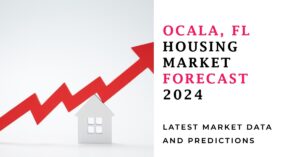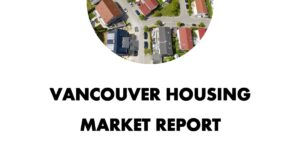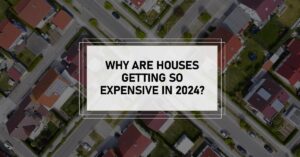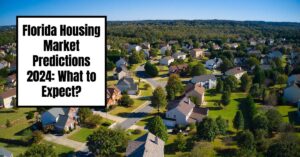The future of the real estate market is a topic that captures the imagination and attention of many—buyers, sellers, investors, and industry professionals alike. What's going to happen with houses and apartments? It's a big question for everyone, whether you're buying, selling, investing, or just working in real estate.
Things are changing, and experts think buying and selling property will look different in the future. Basically, they predict that we'll see lower house prices and more homes for sale. This will likely happen because mortgage rates will go down, and there's a bigger push for eco-friendly homes and using new technology.
Key Takeaways
- Projected Home Price Declines: Experts forecast a decrease in home prices, especially in late 2024, due to higher inventory levels.
- Falling Mortgage Rates: Mortgage rates are expected to stabilize or decline, creating better affordability for buyers and renters.
- Increased Housing Inventory: A significant rise in the supply of new homes is anticipated, improving market conditions for prospective buyers.
- Sustainability Trends: Eco-friendly developments are gaining traction, reflecting consumer demand for sustainable living options.
- Technological Integration: Advances in technology are reshaping real estate transactions, improving efficiency and transparency.
- Changing Demographics and Preferences: Shifts in buyer demographics and work culture are influencing where and how people choose to live.
The Future of Real Estate Market
As we focus on the future of the real estate market, several interconnected factors will shape buyer behavior and market dynamics. Let's explore each of these elements in detail.
1. Economic Conditions and Housing Affordability
One of the most pressing concerns regarding the future of the real estate market revolves around housing affordability. According to a report from Bankrate, many Americans currently face challenges in entering the housing market due to high home prices and rising mortgage rates (Bankrate). However, predictions suggest this landscape may soon shift.
- Home Prices Expected to Ease: Analysts predict that home prices will begin to decline as we move into the latter part of 2024. This decline is largely attributed to rising inventory levels that are set to create more balance between supply and demand.
- Buying Power Restoration: As mortgage rates are expected to range around 6.6% by the end of 2024—down from higher rates in 2023—this could restore purchasing power for many buyers who have been sidelined by previous high rates (USA Today).
Affordability will continue to be a central issue shaping buyer interest and influencing housing decisions nationwide.
2. A Shift in Supply and Demand Dynamics
The dynamics of supply and demand are crucial in determining market conditions and pricing. For several years, the real estate market has experienced extremely low inventory, leading to inflated home prices. However, a significant change is on the horizon:
- Increasing Supply Levels: The construction of new single-family homes is expected to rise, leading to growing inventory, particularly in suburban and rural areas (U.S. News). The rise in inventory is anticipated to ease competitive pressures and provide more options to buyers.
- Market Balancing Effects: This influx of new supply may aid in stabilizing prices and fostering a more balanced real estate environment. First-time homebuyers specifically could find it easier to access the market as more homes become available.
3. The Critical Role of Technology
Advancements in technology will continue to redefine how real estate transactions are made and experienced. As the industry evolves, several technological trends are likely to lead the way:
- Innovations in the Buying Process: Tools such as virtual reality home tours, automated property assessments using AI, and blockchain technology for secure transactions will become more prevalent. This creates a smoother, more user-friendly experience for buyers and sellers looking to navigate the market (PwC).
- Data Analytics and Insights: Technology will also enhance data collection and predictive analytics, allowing real estate professionals to determine market trends quickly. With this valuable insight, agents and buyers alike can make more informed decisions.
4. The Growing Emphasis on Sustainability
As environmental concerns gain prominence, sustainability will be a crucial theme in the future of the real estate market. Buyers are increasingly looking for properties that align with their values regarding sustainability and wellness.
- Eco-friendly Developments: The Global Wellness Institute highlights the emergence of wellness real estate, where properties focus on health, well-being, and sustainability (Global Wellness Institute). Expect to see more buildings with energy-efficient systems, use of sustainable materials, and features like green roofs and solar panels.
- Consumer Preferences Shift: Today's buyers are more inclined to invest in homes that not only provide comfort and style but also align with environmentally responsible practices. This trend is likely to encourage developers to integrate more sustainable practices into their projects.
5. Changes in Residential Preferences Driven by Remote Work
The lasting effects of the COVID-19 pandemic on the work culture have significantly influenced the future of residential real estate. Remote and hybrid work arrangements have altered where individuals prefer to live:
- Suburban and Rural Flight: According to Business Insider, there has been a noticeable trend of individuals moving away from densely populated urban areas to more spacious suburban and rural environments that offer lower cost of living, larger homes, and improved quality of life (Business Insider).
- Desire for Flexibility: With remote work becoming a long-term option for many, buyers are looking for homes with extra space for home offices or flexibility in indoor layouts that can accommodate changing needs.
These shifts in demand will alter market dynamics, prompting developers to consider new locations and types of housing that cater to this emerging preference.
6. The Impact of Changing Demographics
As different generations progress in their careers and lifestyles, there is a notable shift in buyer demographics. Millennials and Gen Z are becoming a significant force in the housing market, leading to unique preferences and priorities.
- Urban Versus Suburban Living: Many young buyers prefer urban environments that offer social amenities and career opportunities but are increasingly interested in suburban options as well, particularly those with good schools and family-friendly features.
- Value of Community: According to research from the National Association of Realtors, younger generations value community aspects and may favor neighborhoods with amenities that promote social interactions and healthy lifestyles (National Association of Realtors).
Understanding these demographic shifts will be critical for investors and developers looking to meet the needs of tomorrow's buyers.
7. Broader Economic Influences
The overall economic climate will inevitably play a significant role in the future of the real estate market. Homeownership has historically been tied to broader economic conditions, and as such, market participants should keep a close eye on economic indicators:
- Inflation and Interest Rates: The inflationary environment and Federal Reserve policies will be critical in influencing home lending rates and overall market responsiveness.
- Financial Market Stability: Continued economic growth or downturns will directly impact consumer confidence and purchasing behavior in the real estate sector. The direction of these economic indicators will affect housing demand and price stability.
My Expert Opinion
In my view, the future of the real estate market presents a unique convergence of challenges and opportunities. While concerns about affordability and supply persist, the integration of sustainability and technology into our industry will set the stage for a transformative era. The ability to adapt to these market changes will be key for those looking to succeed in this evolving landscape.
Concluding Thoughts
Overall, the future of the real estate market is poised for significant changes as we approach 2024 and beyond. The interplay of economic factors, inventory levels, technological innovations, sustainability objectives, and evolving consumer preferences will shape what the housing market looks like in the coming years. As buyers, sellers, and investors navigate these shifts, keeping an eye on emerging trends and understanding market dynamics will provide a firm grounding for decision-making.
Recommended Read:
- Housing Market Predictions for Next Year: Prices to Rise by 4.4%
- Real Estate Market Predictions 2025: What to Expect
- Housing Market Predictions for the Next 4 Years: 2024 to 2028
- Real Estate Forecast Next 5 Years: Top 5 Predictions for Future
- Is the Housing Market on the Brink in 2024: Crash or Boom?
- 2008 Forecaster Warns: Housing Market 2024 Needs This to Survive
- Housing Market Predictions for the Next 2 Years
- Real Estate Forecast Next 10 Years: Will Prices Skyrocket?
- Housing Market Predictions for Next 5 Years (2024-2028)











